A Rate Theory Model of Radiation-Induced Swelling in an Austenitic Stainless Steel
Abstract
1. Introduction
2. Materials and Irradiation
3. Methodology and Analysis
3.1. Atomic Displacement Damage and He Gas Production
3.2. Freely Migrating Point Defects
4. Microstructure Parameters
4.1. Dislocation Density
4.2. Cavity Size and Number Density
5. Swelling Model Development
5.1. Swelling Data
5.2. Rate Theory Model
6. Results
6.1. Effect of Helium on Swelling Rate
6.2. Effect of FMD Production Rate on Swelling Rate
6.3. Effect of Temperature on Swelling
7. Discussion
8. Conclusions
Supplementary Materials
Author Contributions
Funding
Institutional Review Board Statement
Informed Consent Statement
Data Availability Statement
Acknowledgments
Conflicts of Interest
References
- Bhattacharya, A.; Zinkle, S.J. Cavity Swelling in Irradiated Materials. In Comprehensive Nuclear Materials, 2nd ed.; Konings, R.J.M., Stoller, R.E., Eds.; Elsevier: Oxford, UK, 2020; Volume 1, pp. 406–455. [Google Scholar]
- Garner, F.A. Radiation-Induced Damage in Austenitic Structural Steels Used in Nuclear Reactors. In Comprehensive Nuclear Materials, 2nd ed.; Konings, R., Stoller, R., Eds.; Elsevier: Oxford, UK, 2020; Volume 3, pp. 57–168. [Google Scholar]
- Chung, H.M. Assessment of Void Swelling in Austenitic Stainless Steel Core Internals (NUREG/CR-6897, ANL-04/28); Argonne National Lab: Argonne, IL, USA, 2011.
- Zinkle, S.J.; Was, G.S. Materials challenges in nuclear energy. Acta Mater. 2013, 61, 735–758. [Google Scholar] [CrossRef]
- Was, G.S. Fundamentals of Radiation Materials Science: Metals and Alloys; Springer: Berlin/Heidelberg, Germany, 2007. [Google Scholar]
- Mansur, L.K.; Yoo, M.H. Advances in the theory of swelling in irradiated metals and alloys. J. Nucl. Mater. 1979, 85–86, 523–532. [Google Scholar] [CrossRef]
- Mansur, L.K.; Coghlan, W.A. Mechanisms of helium interaction with radiation effects in metals and alloys: A review. J. Nucl. Mater. 1983, 119, 1–25. [Google Scholar] [CrossRef]
- Hishinuma, A.; Mansur, L.K. Critical radius for bias-driven swelling—A further analysis and its application to bimodal cavity size distributions. J. Nucl. Mater. 1983, 118, 91–99. [Google Scholar] [CrossRef]
- Coghlan, W.A.; Mansur, L.K. Critical radius and critical number of gas atoms for cavities containing a Van der Waals gas, for bias-driven swelling—A further analysis and its application to bimodal cavity size distributions. J. Nucl. Mater. 1984, 122, 495–501. [Google Scholar] [CrossRef]
- Stoller, R.E.; Odette, G.R. Analytical Solutions for Helium Bubble and Critical Radius Parameters Using a Hard Sphere Equation of State. J. Nucl. Mater. 1985, 131, 118–125. [Google Scholar] [CrossRef]
- Stoller, R.E.; Odette, R.G. A Comparison of the Relative Importance of Helium and Vacancy Accumulation in Void Nucleation, 13th International Symposium on Radiation Induced Changes in Microstructure; Garner, F.A., Packan, N.H., Kumar, A.S., Eds.; ASTM: Philadelphia, PA, USA, 1987; pp. 358–370. [Google Scholar]
- Stoller, R.E.; Odette, R.G. A Composite Model of Microstructure Evolution in Austenitic Steels Under Fast Neutron Irradiation, In Proceedings of the 13th International Symposium on Radiation Induced Changes in Microstructure; Seattle, WA, USA, 23–25 June 1986; Garner, F.A., Packan, N.H., Kumar, A.S., Eds.; ASTM: Philadelphia, PA, USA, 1987; pp. 371–392. [Google Scholar]
- Mansur, L.K. Theory and experimental background on dimensional changes in irradiated alloys. J. Nucl. Mater. 1994, 216, 97–123. [Google Scholar] [CrossRef]
- Golubov, S.I.; Barashev, A.V.; Stoller, R.E. Radiation damage theory. In Comprehensive Nuclear Materials, 1st ed.; Elsevier: Amsterdam, The Netherlands, 2012; pp. 357–391. [Google Scholar] [CrossRef]
- Olander, D.R. Fundamental Aspects of Nuclear Reactor Fuel Elements, TID 26711-Part 1; University of Michigan Library: Ann Arbor, MI, USA, 1976. [Google Scholar]
- Packan, N.H.; Farrell, K.; Stiegler, J.O. Correlation of neutron and heavy-ion damage. I. The influence of dose rate and injected helium on swelling in pure nickel. J. Nucl. Mater. 1978, 78, 143–155. [Google Scholar] [CrossRef]
- Greenwood, L.R. Neutron Interactions and Atomic Recoil Spectra. J. Nucl. Mater. 1994, 216, 29–44. [Google Scholar] [CrossRef]
- Greenwood, L.R.; Oliver, B.M. Comparison of Predicted and Measured Helium Production in US BWR Reactors. J. ASTM Int. 2006, 3, 9. [Google Scholar] [CrossRef]
- Greenwood, L.R. Gas Production in Reactor Materials. J. ASTM Int. 2006, 3, 1–6. [Google Scholar] [CrossRef]
- Griffiths, M.; Walters, L.; Greenwood, L.R.; Garner, F.A. Accelerated materials evaluation for nuclear applications. J. Nucl. Mater. 2017, 488, 46–62. [Google Scholar] [CrossRef]
- Griffiths, M. Microstructure Evolution in HCP Metals during Irradiation. Phil. Mag. 1991, 63, 835. [Google Scholar] [CrossRef]
- Adamson, R.B.; Coleman, C.E.; Griffiths, M. Irradiation creep and growth of zirconium alloys. J. Nucl. Mater. 2019, 521, 167–244. [Google Scholar] [CrossRef]
- Faulkner, D.; Woo, C.H. Void Swelling in Zirconium. J. Nucl. Mater. 1980, 90, 307–316. [Google Scholar] [CrossRef]
- Griffiths, M. Microstructure Evolution in Zr Alloys during Irradiation: Dose, Dose Rate, and Impurity Dependence. J. ASTM Int. 2007, 5, 1–8. [Google Scholar]
- Dai, Y.; Odette, G.R.; Yamamoto, T. The effects of helium in irradiated structural alloys. In Comprehensive Nuclear Materials; Konings, R.J.M., Ed.; Elsevier Science: Amsterdam, The Netherlands, 2012; pp. 141–193. [Google Scholar] [CrossRef]
- Griffiths, M. Ni-Based Alloys for Reactor Internals and Steam Generator Applications. In Structural Alloys for Nuclear Energy Applications; Zinkle, S., Odette, R., Eds.; Elsevier: Amsterdam, The Netherlands, 2019; ISBN 9780123970466. [Google Scholar]
- Griffiths, M.; Boothby, R. Radiation Effects in Nickel-Based Alloys. In Comprehensive Nuclear Materials, 2nd ed.; Konings, R.J.M., Stoller, R.E., Eds.; Elsevier: Oxford, UK, 2000; Volume 3, pp. 334–337. [Google Scholar]
- Maziasz, P.J.; Busby, J.T. Properties of Austenitic Steels for Nuclear Reactor Applications, 2nd ed.; Konings, R.J.M., Stoller, R.E., Eds.; Elsevier: Oxford, UK, 2020; Volume 7, pp. 303–318. [Google Scholar]
- Raj, B.; Vijayalakshmi, M. Ferritic Steels and Advanced Ferritic–Martensitic Steels. Compr. Nucl. Mater. 2012, 4, 97–121. [Google Scholar]
- Little, E.A. Void-swelling in irons and ferritic steels: I. Mechanisms of swelling suppression. J. Nucl. Mater. 1979, 87, 11–24. [Google Scholar] [CrossRef]
- Ghoniem, N.M.; Sharafat, S. A Numerical Solution to the Fokker-Planck Equation Describing the Evolution of the Interstitial Loop Microstructure during Irradiation. J. Nucl. Mater. 1980, 92, 121–135. [Google Scholar] [CrossRef]
- Ghoniem, N.M.; Kulcinski, G.L. The use of the fully dynamic rate theory to predict void growth in metals. Radiat. Eff. 1979, 41, 81–89. [Google Scholar] [CrossRef]
- Garner, F.A.; Gelles, D.S. Neutron-induced swelling of commercial alloys at very high exposures, 1990. In Proceedings of the 14th International Symposium on Effects of Radiation on Materials, Andover, MA, USA, 27–30 June 1988; pp. 673–683. [Google Scholar]
- Greenwood, L.R.; Smither, R.K. SPECTER: Neutron Damage Calculations for Materials Irradiation; Springfield: Springfield, IL, USA, 1985; Available online: https://www-nds.iaea.org/irdf2002/codes/index.htmlx (accessed on 8 February 2017).
- Greenwood, L.R. A New Calculation of Thermal Neutron Damage and Helium Production in Nickel. J. Nucl. Mater. 1983, 2, 137–142. [Google Scholar] [CrossRef]
- Greenwood, L.R.; Garner, F.A. Hydrogen Generation Arising from the 59Ni (n,p) Reaction and its impact on Fission-Fusion Correlations. J. Nucl. Mater. 1996, 233, 1530–1534. [Google Scholar] [CrossRef]
- Greenwood, L.R. Recent Developments in Neutron Dosimetry and Radiation Damage Calculations for Fusion Materials Studies. J. Nucl. Mater. 1984, 122–123, 1011–1016. [Google Scholar] [CrossRef]
- Brailsford, A.D.; Bullough, R. Rate Theory of Swelling Due to Void Growth in Irradiated Metals. J. Nucl. Mater. 1972, 44, 121–135. [Google Scholar] [CrossRef]
- Ghoniem, N.M.; Takata, M.L. A Rate Theory of Swelling Induced by Helium and Displacement Damage in Fusion Reactor Structural Materials. J. Nucl. Mater. 1982, 105, 276–292. [Google Scholar] [CrossRef]
- Mansur, L.K.; Lee, E.H.; Maziasz, P.J.; Rowcliffe, A.P. Control of Helium Effects in Irradiated Materials Based on Theory and Experiment. J. Nucl. Mater. 1986, 141, 633–646. [Google Scholar] [CrossRef]
- Kramer, D.; Brager, H.R.; Rhodes, C.G.; Pard, A.G. Helium embrittlement in type 304 stainless steel. J. Nucl. Mater. 1968, 25, 121–131. [Google Scholar] [CrossRef]
- Schroeder, H.; Batfalsky, P. The dependence of the high temperature mechanical properties of austenitic stainless steels on implanted helium. J. Nucl. Mater. 1983, 115, 297–306. [Google Scholar] [CrossRef]
- Schroeder, H.; Braski, D.N. The effect of implanted helium on the high temperature mechanical properties of a model austenitic Fe-17% Cr-17% Ni alloy. J. Nucl. Mater. 1983, 117, 287–294. [Google Scholar] [CrossRef]
- Schroeder, H. High temperature helium embrittlement in austenitic stainless steels. Correlations between microstructure and mechanical properties. J. Nucl. Mater. 1988, 155, 1032–1037. [Google Scholar] [CrossRef]
- Schroeder, H.; Dai, Y. Helium concentration dependence of embrittlement effects.in DIN 1.4970, 13% cw austenitic stainless steel at 873 K. J. Nucl. Mater. 1992, 191, 781–785. [Google Scholar] [CrossRef]
- Rowcliffe, A.F.; Mansur, L.K.; Hoelzer, D.T.; Nanstad, R.K. Perspectives on Radiation Effects in Nickel-Base Alloys for Applications in Advanced Reactors. J. Nucl. Mater. 2009, 392, 341–352. [Google Scholar] [CrossRef]
- Grossbeck, M.L.; Ehrlich, K.; Wassilew, C. An assessment of tensile, irradiation creep, creep rupture, and fatigue behavior in austenitic stainless steels with emphasis on spectral effects. J. Nucl. Mater. 1990, 174, 264–281. [Google Scholar] [CrossRef]
- Hamilton, M.L.; Okada, A.; Garner, F.A. Tensile behavior and swelling of ternary austenitic alloys irradiated in different neutron spectra. J. Nucl. Mater. 1991, 179, 558–562. [Google Scholar] [CrossRef]
- Yoo, H.M.; Mansur, K.L. General rate theory model of void swelling in irradiated metals. In Proceedings of the ANS Winter Meeting, San Francisco, CA, USA, 27 November 1977. [Google Scholar]
- Yoo, M.H.; Mansur, L.K. The Inclusion of Mobile Helium in a Rate Theory Model of Void Swelling. J. Nucl. Mater. 1979, 85, 571–575. [Google Scholar] [CrossRef][Green Version]
- Griffiths, M. Effect of Neutron Irradiation on the Mechanical Properties, Swelling and Creep of Austenitic Stainless Steels. Materials 2021, 14, 2622. [Google Scholar] [CrossRef] [PubMed] [PubMed Central]
- Garner, F.A.; Simonen, E.P.; Oliver, B.M.; Greenwood, L.R.; Grossbeck, M.L.; Wolfer, W.G.; Scott, P.M. Retention of Hydrogen in FCC Metals Irradiated at Temperatures Leading to High Densities of Bubbles or Voids. J. Nucl. Mater. 2006, 356, 122–135. [Google Scholar] [CrossRef]
- Mills, W.J.; Lebo, M.R.; Kearns, J.J. Hydrogen embrittlement, grain boundary segregation and stress corrosion cracking of alloy X-750 in low and high-temperature water. Metall. Mater. Trans. 1999, 30, 1579–1596. [Google Scholar] [CrossRef]
- Gao, F.; Wooding, S.J.; Calder, A.F.; Bacon, D.J. Computer Simulation of Displacement Cascade Damage in Metals. Mat. Res. Soc. Symp. Proc. 1995, 373, 15. [Google Scholar] [CrossRef]
- Wooding, S.; Howe, L.; Gao, F.; Calder, A.; Bacon, D. A molecular dynamics study of high-energy displacement cascades in α-zirconium. J. Nucl. Mater. 1998, 254, 191–204. [Google Scholar] [CrossRef]
- Norgett, M.; Robinson, M.; Torrens, I. A proposed method of calculating displacement dose rates. Nucl. Eng. Des. 1975, 33, 50–54. [Google Scholar] [CrossRef]
- Kwon, J.; Motta, A.T. Role of Radiation in BWR Core Shroud Cracking. In Reactor Dosimetry; ASTM STP: West Conshohocken, PA, USA, 2000. [Google Scholar]
- Faulkner, R.G.; Bacon, D.J.; Song, S.; Flewitt, P.E.J. Neutron energy spectrum and temperature effects on freely migrating defect concentrations and grain boundary segregation in α-Fe. J. Nucl. Mater. 1999, 271, 1–6. [Google Scholar] [CrossRef]
- Petrovic, B.; Haghighat, A.; Motta, A.; Kucukboyaci, V.; Kwon, J. Contribution of Gamma Irradiation to Material Damage at BWR Core Shroud and Pressure Vessel. In Proceedings of the 1998 Radiation Protection and Shielding Conference, Nashville, TN, USA, 19–23 April 1998. [Google Scholar]
- Corrigall, L.; Griffiths, M.; Petrovic, B.; Greenwood, L.R. Radiation Effects Related to Repaired BWR Core Shrouds. J. Nucl. Mater. 2021, 551, 152932. [Google Scholar] [CrossRef]
- Rehn, L.E.; Okamoto, P.R.; Averback, R.S. Relative Efficiencies of Different Ions for Producing Freely Migrating Defects. Phys. Rev. 1984, 30, 3073–3079. [Google Scholar] [CrossRef]
- Rehn, L.E. Production of Freely Migrating Defects. J. Nucl. Mater. 1990, 174, 144–150. [Google Scholar] [CrossRef]
- Okamoto, P.R.; Rehn, L.E.; Averback, R.S. Effects of Primary Recoil Energy on the Production Rate of Mobile Defects during Elevated Temperature Irradiation. J. Nucl. Mater. 1985, 133, 373–377. [Google Scholar] [CrossRef][Green Version]
- Naundorf, V.; Macht, M.P.; Wollenberger, H. Production Rate of Freely Migrating Defects for Ion Irradiation. J. Nucl. Mater. 1992, 186, 227. [Google Scholar] [CrossRef]
- Okamoto, P.R.; Rehn, L.E.; Averback, R.S. Solute Redistribution Processes in Ion Bombarded Alloys. J. Nucl. Mater. 1982, 108, 319–330. [Google Scholar] [CrossRef]
- Svetukhin, V.; Tikhonchev, M. Effective Atomic Displacements in α-Zirconium under Neutron Irradiation. Adv. Mater. Res. 2014, 1042, 52–57. [Google Scholar] [CrossRef]
- Heald, P.T.; Speight, M.V. Point Defect Behaviour in Irradiated Materials. Acta. Metall. 1975, 23, 1389. [Google Scholar] [CrossRef]
- Gilbert, E.R.; Garner, F.A. The influence of cold-work level on the irradiation creep and swelling of AISI 316 stainless steel irradiated as pressurized tubes in the EBR-II fast reactor. J. Nucl. Mater. 2007, 367, 954–959. [Google Scholar] [CrossRef]
- Garnier, J.; Dubuisson, P.; Delnondedieu, M.; Massoud, J.P.; Bréchet, Y.; Leclercq, S.; Besson, J.; Scott, P.; Averty, X.; Rozenblum, F. Deformation under irradiation of 304L and 316 austenitic stainless steels. In Proceedings of the 13th Conference on Environmental Degradation of Materials in Nuclear Power Systems–Water Reactors, Whistler, BC, Canada, 19–23 August 2007. [Google Scholar]
- Garner, F.A.; Hamilton, M.L.; Panayotou, N.F.; Johnson, G.D. The microstructural origins of yield strength changes in aisi 316 during fission or fusion irradiation. J. Nucl. Mater. 1981, 103, 803–808. [Google Scholar] [CrossRef]
- Wiedersich, H. On the Theory of Void Formation during Irradiation. Radiat. Eff. 1972, 12, 111–125. [Google Scholar] [CrossRef]
- Heald, P.T.; Harbottle, J.E. Irradiation Creep Due to Dislocation Climb and Glide. J. Nucl. Mater. 1977, 67, 229. [Google Scholar] [CrossRef]
- Harkness, S.D.; Li, C.Y. A Study of Void Formation in Fast Neutron-Irradiated Metals. Met. Trans. 1971, 2, 1457–1470. [Google Scholar]
- Phillipps, K.; Sonnenberg, K. Interstitial Diffusion of He in Nickel. J. Nucl. Mater. 1983, 114, 95–97. [Google Scholar] [CrossRef]
- Zhang, C.H.; Chen, K.Q.; Zhu, Z.Y. Diffusion and Agglomeration of helium I stainless steel in the temperature range of RT to 600 C. NIMB 2000, 169, 64–71. [Google Scholar] [CrossRef]
- Phillipps, K.; Sonnenberg, K.; Williams, J.M. Diffusion of He in Nickel. J. Nucl. Mater. 1982, 107, 271–279. [Google Scholar] [CrossRef]
- Carnahan, N.F.; Starling, K.E. Equation of State for Nonattracting Rigid Spheres. J. Chem. Phys. 1969, 51, 635–636. [Google Scholar] [CrossRef]
- Okita, T.; Sato, T.; Sekimura, N.; Garner, F.A.; Greenwood, L.R.; Wolfer, W.G.; Isobe, Y. Neutron-Induced Microstructural Evolution of Fe-15Cr-16Ni Alloys at ~400 C During Neutron Irradiation in the FFTF Fast Reactor, Fusion Materials: Semi-Annual Progress Report for Period Ending June 30, 2001; Department of Energy, Office of Fusion Energy Sciences: Washington, DC, USA, 2001; pp. 148–164.


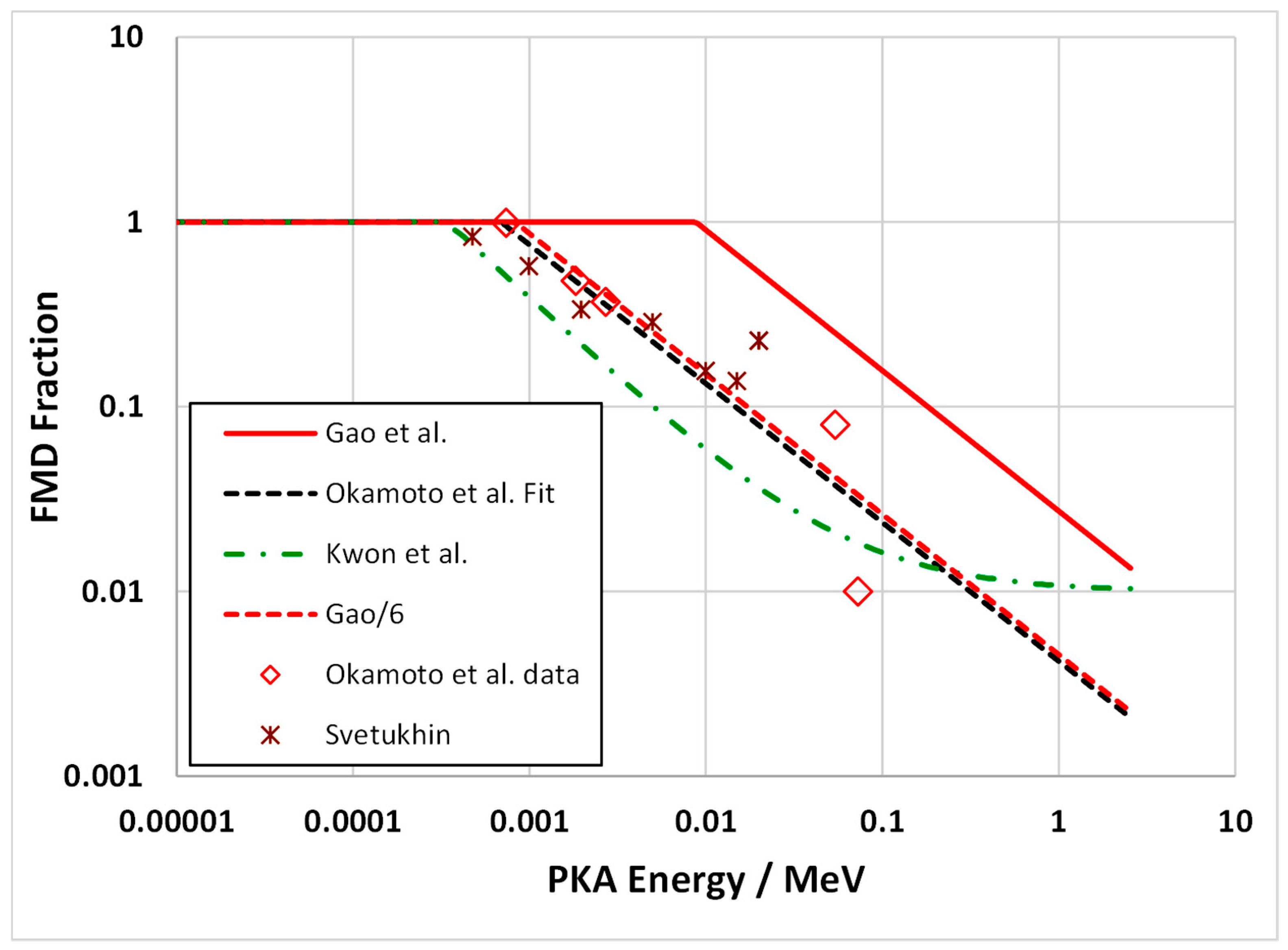
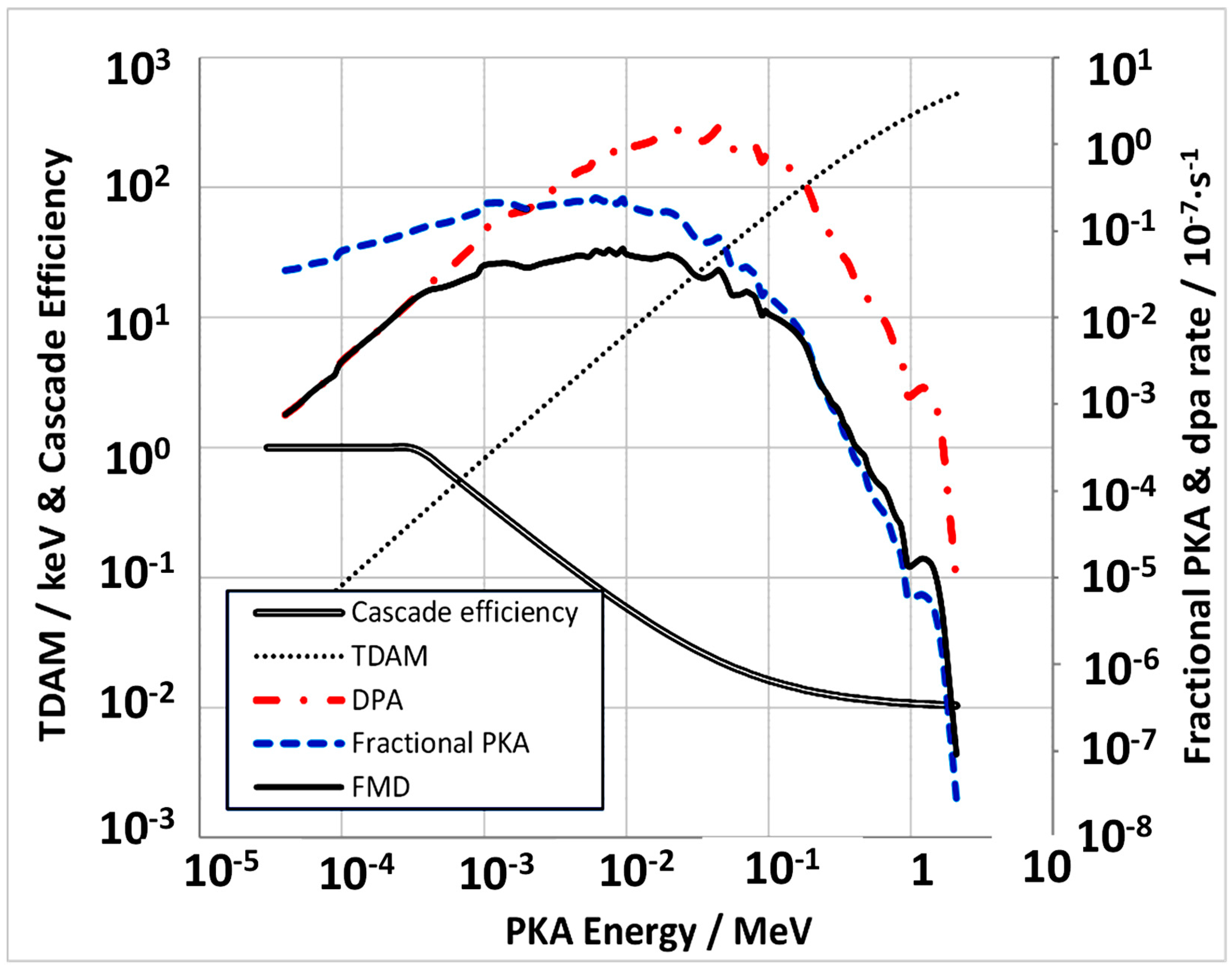
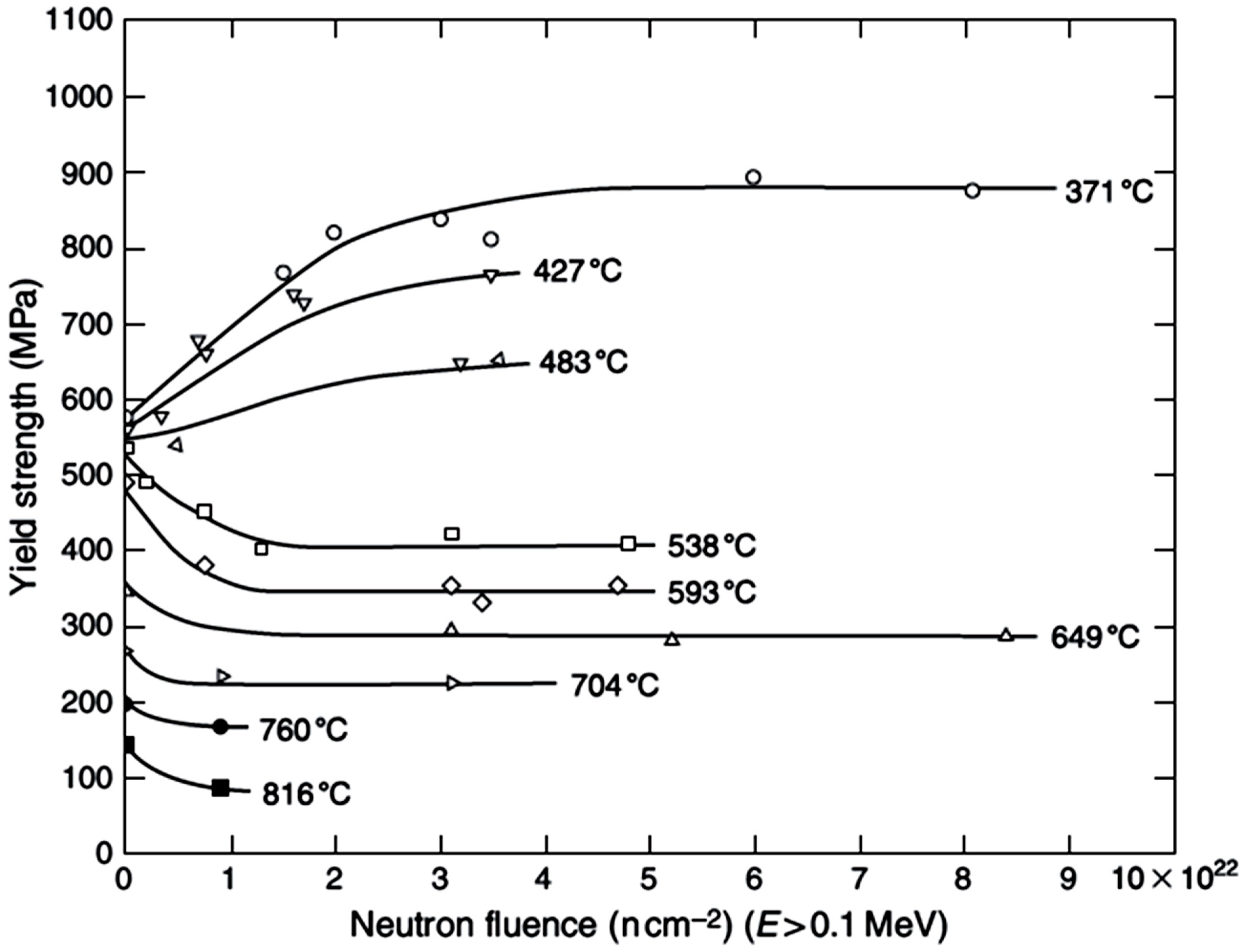

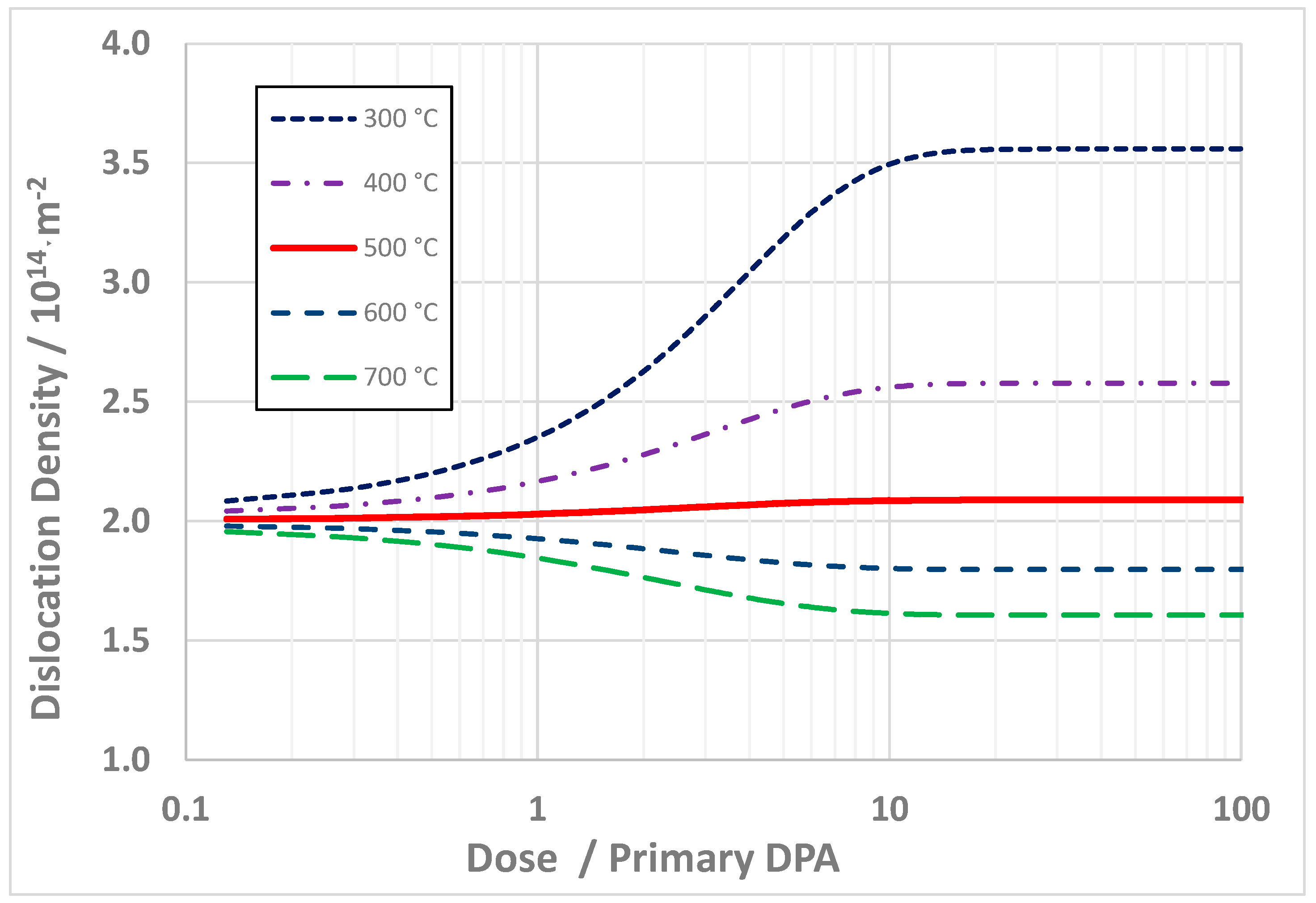


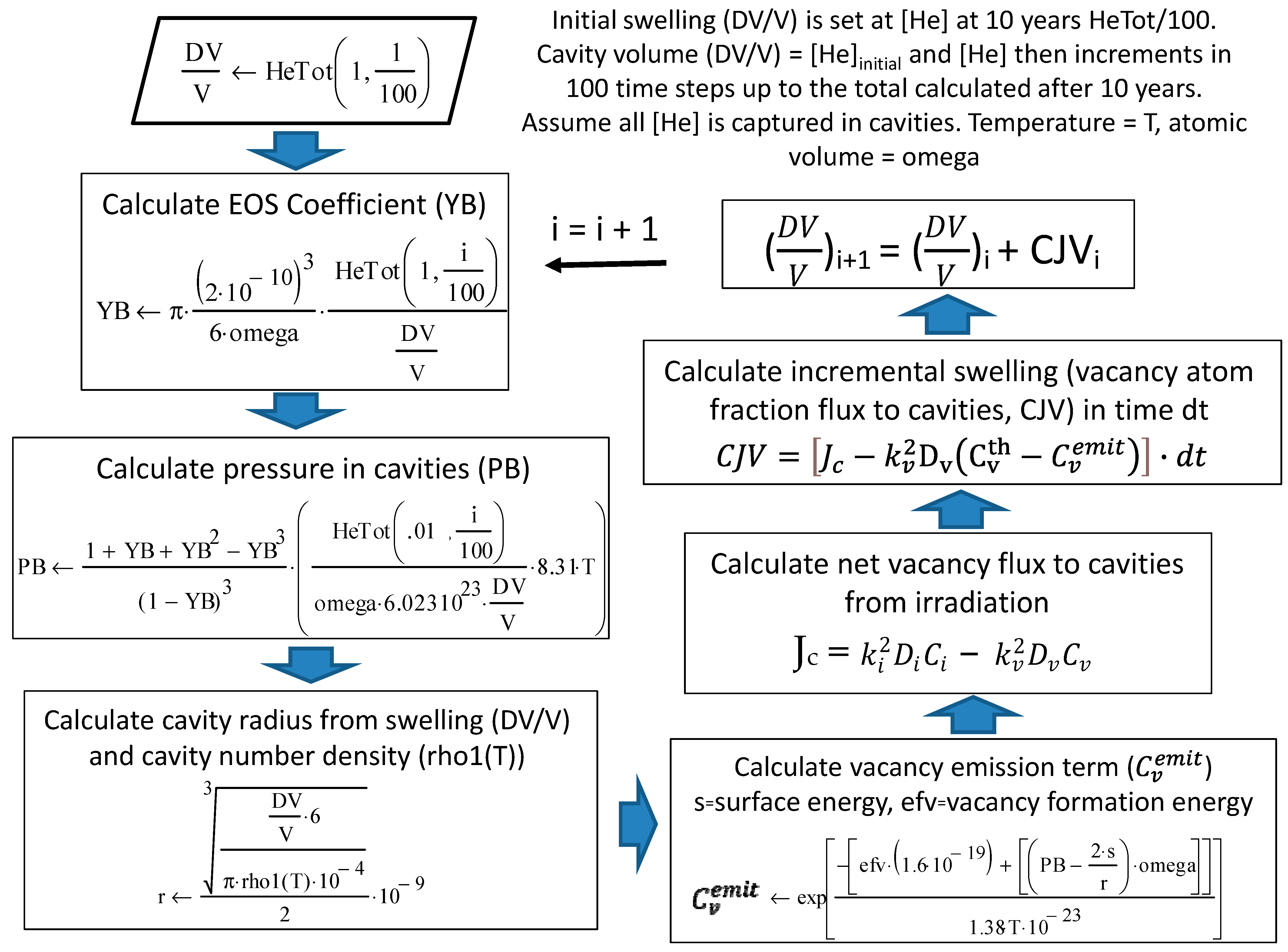
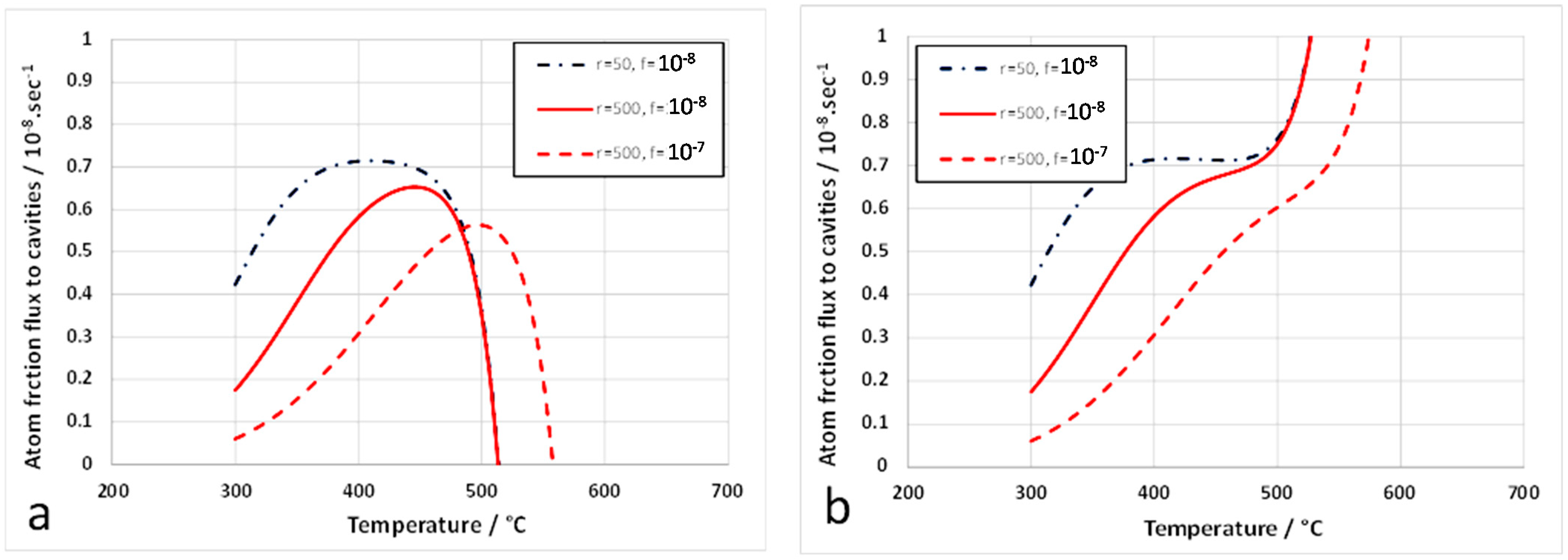
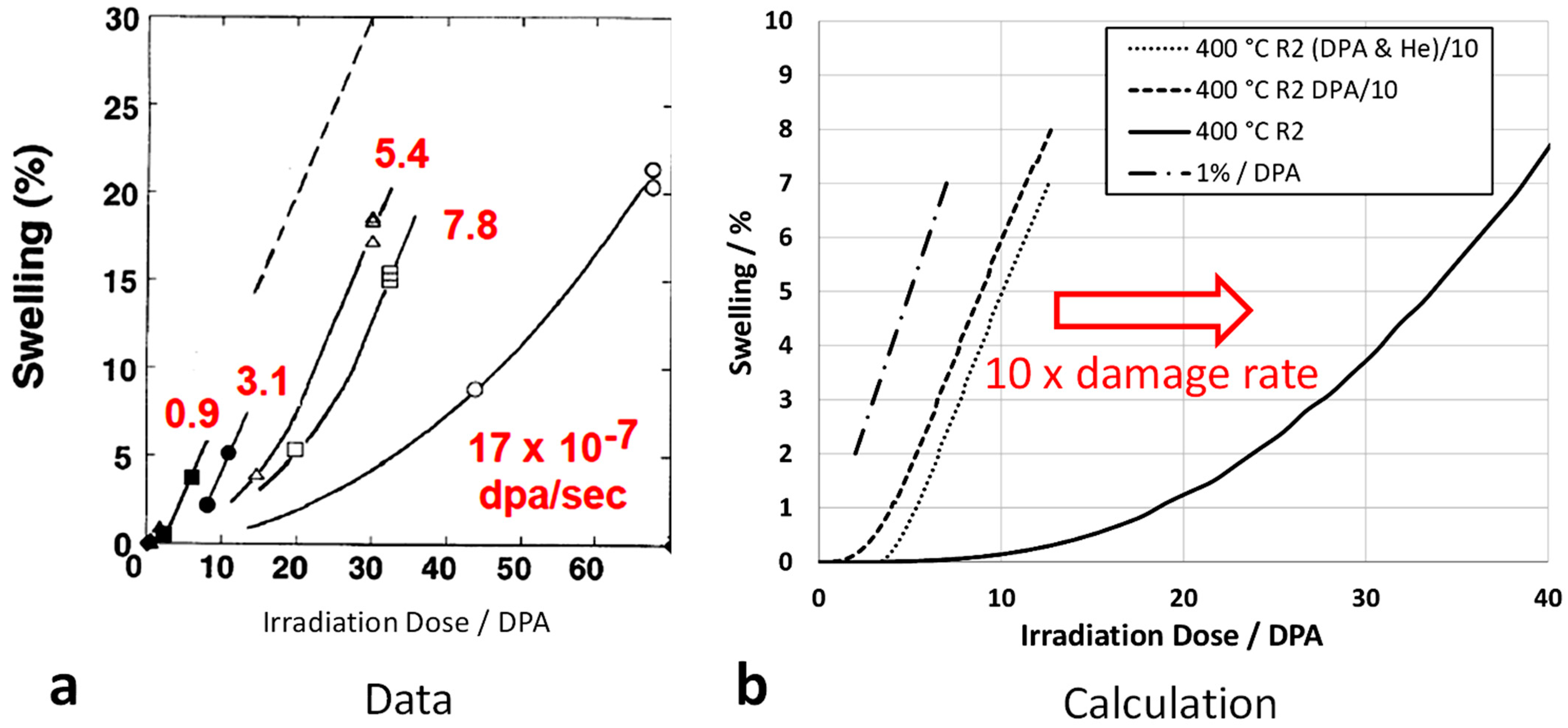
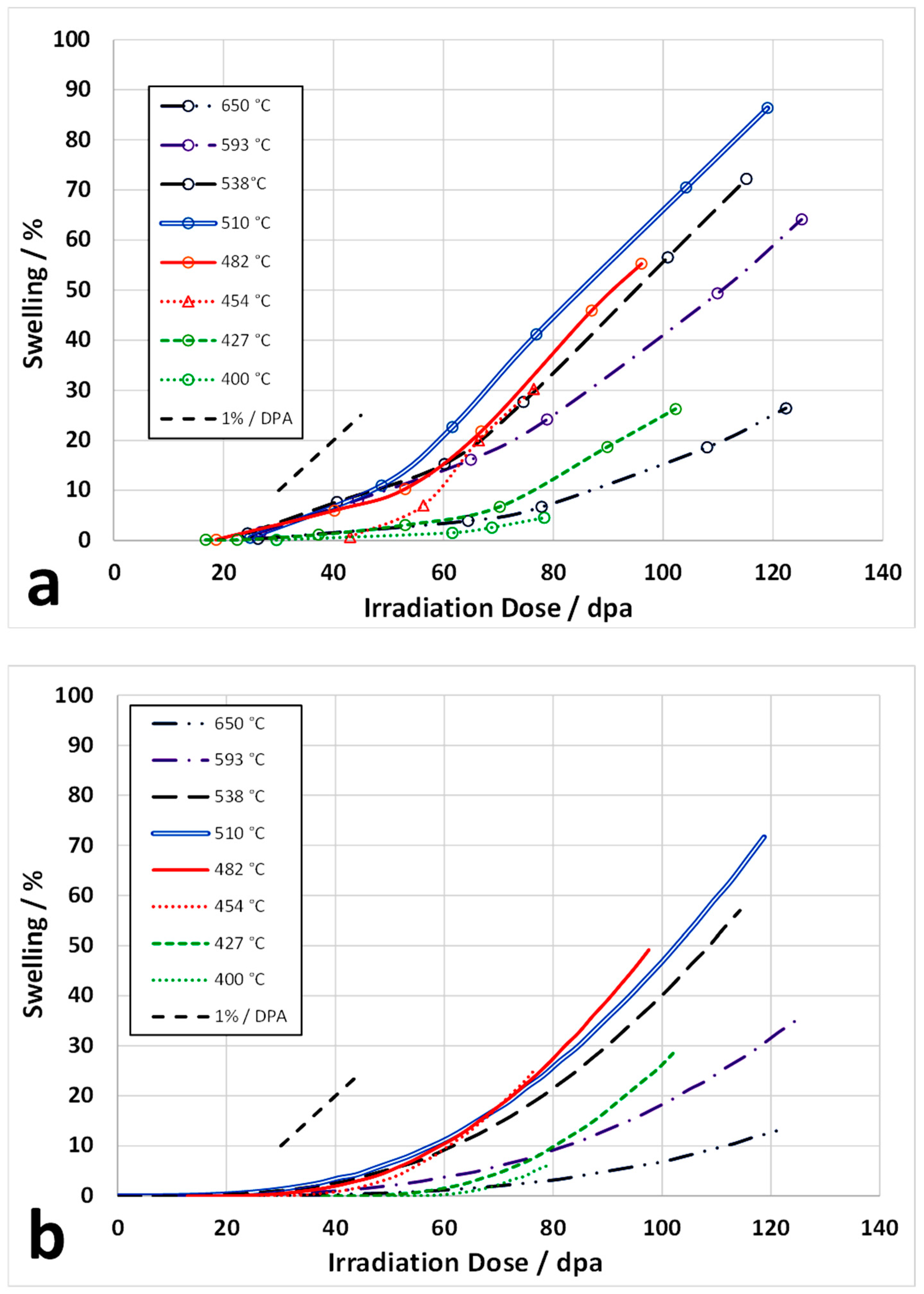

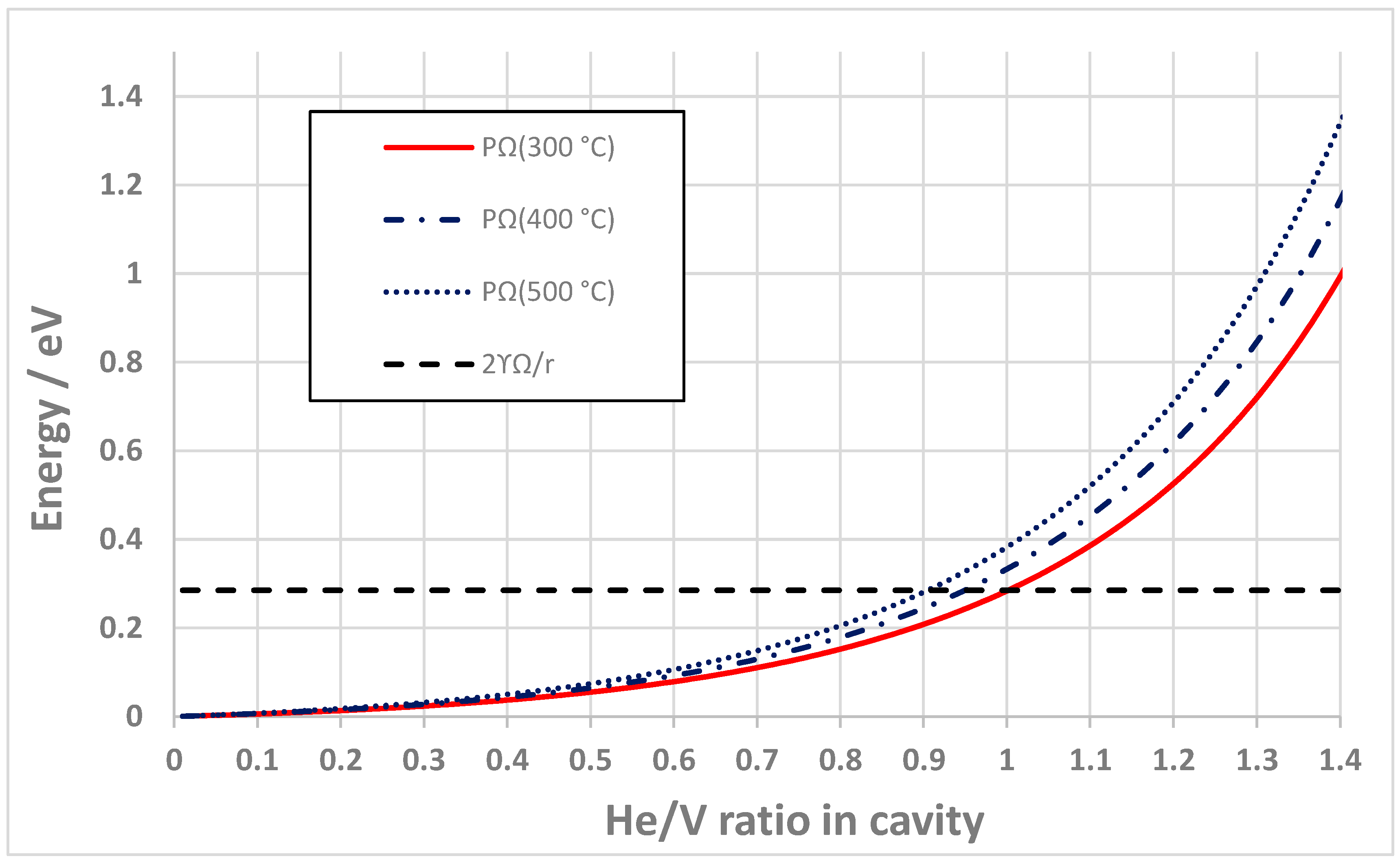


| 400 °C | 482 °C | 538 °C | |||
| Fluence | % Swelling | Fluence | % Swelling | Fluence | % Swelling |
| 6.76 | 0.12 | 4.25 | 0.16 | 5.56 | 1.45 |
| 14.07 | 1.54 | 9.16 | 5.97 | 9.27 | 7.71 |
| 15.71 | 2.61 | 12.11 | 10.29 | 13.75 | 15.28 |
| 17.89 | 4.54 | 15.27 | 21.79 | 17.02 | 27.65 |
| 19.85 | 45.92 | 23.02 | 56.56 | ||
| 427 °C | 21.93 | 55.27 | 26.29 | 72.21 | |
| Fluence | % Swelling | ||||
| 3.82 | 0.16 | 510 °C | 593 °C | ||
| 5.13 | 0.14 | Fluence | % Swelling | Fluence | % Swelling |
| 8.51 | 1.18 | 5.67 | 0.57 | 6.11 | 1.66 |
| 12.11 | 3.09 | 11.13 | 10.96 | 10.15 | 8.14 |
| 16.04 | 6.74 | 14.07 | 22.68 | 14.84 | 16.13 |
| 20.51 | 18.67 | 17.56 | 41.16 | 18.00 | 24.15 |
| 23.35 | 26.25 | 23.78 | 70.50 | 25.09 | 49.34 |
| 27.16 | 86.36 | 28.58 | 64.11 | ||
| 454 °C | |||||
| Fluence | % Swelling | 650 °C | |||
| 9.82 | 0.73 | Fluence | % Swelling | ||
| 12.87 | 7.01 | 6.00 | 0.35 | ||
| 15.16 | 20.05 | 14.73 | 3.93 | ||
| 17.45 | 30.26 | 17.78 | 6.72 | ||
| 24.65 | 18.61 | ||||
| 27.93 | 26.41 | ||||
| Material | Ni | Cr | Fe | C | Mn | Ti | Si | Mo |
|---|---|---|---|---|---|---|---|---|
| 316 (wt%) | 12 | 17.0 | 67.3 | 0.08 | 2 | 0.5 | 1.0 | 2.5 |
| 316 (at%) | 11 | 17.6 | 64.5 | 0.4 | 2 | 0.6 | 1.9 | 1.4 |
| Parameter | Value | Reference |
|---|---|---|
| Vacancy migration energy | 1.4 eV | [32] |
| Vacancy formation energy | 1.6 eV | [32] |
| Interstitial migration energy | 0.15 eV | [32] |
| Interstitial formation energy | 3 eV | [32] |
| Pre-exponential factor, | 12 × 10−6 | [32] |
| Pre-exponential factor, | 6 × 10−6 | [32] |
| Recombination factor | 50 or 500 | [15] |
| He Interstitial Migration Energy | 0.14 eV | [74] |
| He Interstitial Pre-exponential factor, | 12 × 10−6 | [32] |
| Lattice Parameter, a0 | 0.363 nm | [39] |
| Surface Energy, S | 1 or 2 J·m−2 | [9] or [75] |
Publisher’s Note: MDPI stays neutral with regard to jurisdictional claims in published maps and institutional affiliations. |
© 2021 by the authors. Licensee MDPI, Basel, Switzerland. This article is an open access article distributed under the terms and conditions of the Creative Commons Attribution (CC BY) license (https://creativecommons.org/licenses/by/4.0/).
Share and Cite
Griffiths, M.; Ramos-Nervi, J.; Greenwood, L. A Rate Theory Model of Radiation-Induced Swelling in an Austenitic Stainless Steel. J. Nucl. Eng. 2021, 2, 484-515. https://doi.org/10.3390/jne2040034
Griffiths M, Ramos-Nervi J, Greenwood L. A Rate Theory Model of Radiation-Induced Swelling in an Austenitic Stainless Steel. Journal of Nuclear Engineering. 2021; 2(4):484-515. https://doi.org/10.3390/jne2040034
Chicago/Turabian StyleGriffiths, Malcolm, Juan Ramos-Nervi, and Larry Greenwood. 2021. "A Rate Theory Model of Radiation-Induced Swelling in an Austenitic Stainless Steel" Journal of Nuclear Engineering 2, no. 4: 484-515. https://doi.org/10.3390/jne2040034
APA StyleGriffiths, M., Ramos-Nervi, J., & Greenwood, L. (2021). A Rate Theory Model of Radiation-Induced Swelling in an Austenitic Stainless Steel. Journal of Nuclear Engineering, 2(4), 484-515. https://doi.org/10.3390/jne2040034






